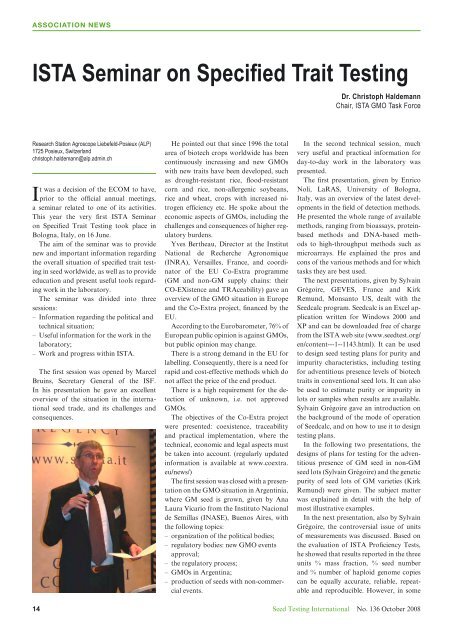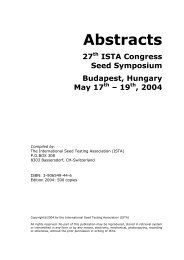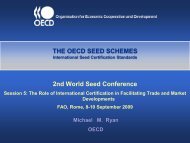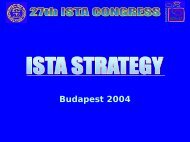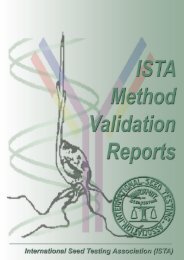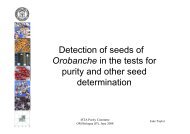(ISTA News Bulletin) No. 136, October 2008 - International Seed ...
(ISTA News Bulletin) No. 136, October 2008 - International Seed ...
(ISTA News Bulletin) No. 136, October 2008 - International Seed ...
You also want an ePaper? Increase the reach of your titles
YUMPU automatically turns print PDFs into web optimized ePapers that Google loves.
Association news<br />
<strong>ISTA</strong> Seminar on Specified Trait Testing<br />
Dr. Christoph Haldemann<br />
Chair, <strong>ISTA</strong> GMO Task Force<br />
Research Station Agroscope Liebefeld-Posieux (ALP)<br />
1725 Posieux, Switzerland<br />
christoph.haldemann@alp.admin.ch<br />
It was a decision of the ECOM to have,<br />
prior to the official annual meetings,<br />
a seminar related to one of its activities.<br />
This year the very first <strong>ISTA</strong> Seminar<br />
on Specified Trait Testing took place in<br />
Bologna, Italy, on 16 June.<br />
The aim of the seminar was to provide<br />
new and important information regarding<br />
the overall situation of specified trait testing<br />
in seed worldwide, as well as to provide<br />
education and present useful tools regarding<br />
work in the laboratory.<br />
The seminar was divided into three<br />
sessions:<br />
– Information regarding the political and<br />
technical situation;<br />
– Useful information for the work in the<br />
laboratory;<br />
– Work and progress within <strong>ISTA</strong>.<br />
The first session was opened by Marcel<br />
Bruins, Secretary General of the ISF.<br />
In his presentation he gave an excellent<br />
overview of the situation in the international<br />
seed trade, and its challenges and<br />
consequences.<br />
He pointed out that since 1996 the total<br />
area of biotech crops worldwide has been<br />
continuously increasing and new GMOs<br />
with new traits have been developed, such<br />
as drought-resistant rice, flood-resistant<br />
corn and rice, non-allergenic soybeans,<br />
rice and wheat, crops with increased nitrogen<br />
efficiency etc. He spoke about the<br />
economic aspects of GMOs, including the<br />
challenges and consequences of higher regulatory<br />
burdens.<br />
Yves Bertheau, Director at the Institut<br />
National de Recherche Agronomique<br />
(INRA), Versailles, France, and coordinator<br />
of the EU Co-Extra programme<br />
(GM and non-GM supply chains: their<br />
CO-EXistence and TRAceability) gave an<br />
overview of the GMO situation in Europe<br />
and the Co-Extra project, financed by the<br />
EU.<br />
According to the Eurobarometer, 76% of<br />
European public opinion is against GMOs,<br />
but public opinion may change.<br />
There is a strong demand in the EU for<br />
labelling. Consequently, there is a need for<br />
rapid and cost-effective methods which do<br />
not affect the price of the end product.<br />
There is a high requirement for the detection<br />
of unknown, i.e. not approved<br />
GMOs.<br />
The objectives of the Co-Extra project<br />
were presented: coexistence, traceability<br />
and practical implementation, where the<br />
technical, economic and legal aspects must<br />
be taken into account. (regularly updated<br />
information is available at www.coextra.<br />
eu/news/)<br />
The first session was closed with a presentation<br />
on the GMO situation in Argentinia,<br />
where GM seed is grown, given by Ana<br />
Laura Vicario from the Instituto Nacional<br />
de Semillas (INASE), Buenos Aires, with<br />
the following topics:<br />
– organization of the political bodies;<br />
– regulatory bodies: new GMO events<br />
approval;<br />
– the regulatory process;<br />
– GMOs in Argentina;<br />
– production of seeds with non-commercial<br />
events.<br />
In the second technical session, much<br />
very useful and practical information for<br />
day-to-day work in the laboratory was<br />
presented.<br />
The first presentation, given by Enrico<br />
<strong>No</strong>li, LaRAS, University of Bologna,<br />
Italy, was an overview of the latest developments<br />
in the field of detection methods.<br />
He presented the whole range of available<br />
methods, ranging from bioassays, proteinbased<br />
methods and DNA-based methods<br />
to high-throughput methods such as<br />
microarrays. He explained the pros and<br />
cons of the various methods and for which<br />
tasks they are best used.<br />
The next presentations, given by Sylvain<br />
Grégoire, GEVES, France and Kirk<br />
Remund, Monsanto US, dealt with the<br />
<strong>Seed</strong>calc program. <strong>Seed</strong>calc is an Excel application<br />
written for Windows 2000 and<br />
XP and can be downloaded free of charge<br />
from the <strong>ISTA</strong> web site (www.seedtest.org/<br />
en/content---1--1143.html). It can be used<br />
to design seed testing plans for purity and<br />
impurity characteristics, including testing<br />
for adventitious presence levels of biotech<br />
traits in conventional seed lots. It can also<br />
be used to estimate purity or impurity in<br />
lots or samples when results are available.<br />
Sylvain Grégoire gave an introduction on<br />
the background of the mode of operation<br />
of <strong>Seed</strong>calc, and on how to use it to design<br />
testing plans.<br />
In the following two presentations, the<br />
designs of plans for testing for the adventitious<br />
presence of GM seed in non-GM<br />
seed lots (Sylvain Grégoire) and the genetic<br />
purity of seed lots of GM varieties (Kirk<br />
Remund) were given. The subject matter<br />
was explained in detail with the help of<br />
most illustrative examples.<br />
In the next presentation, also by Sylvain<br />
Grégoire, the controversial issue of units<br />
of measurements was discussed. Based on<br />
the evaluation of <strong>ISTA</strong> Proficiency Tests,<br />
he showed that results reported in the three<br />
units % mass fraction, % seed number<br />
and % number of haploid genome copies<br />
can be equally accurate, reliable, repeatable<br />
and reproducible. However, in some<br />
14<br />
<strong>Seed</strong> Testing <strong>International</strong> <strong>No</strong>. <strong>136</strong> <strong>October</strong> <strong>2008</strong>


